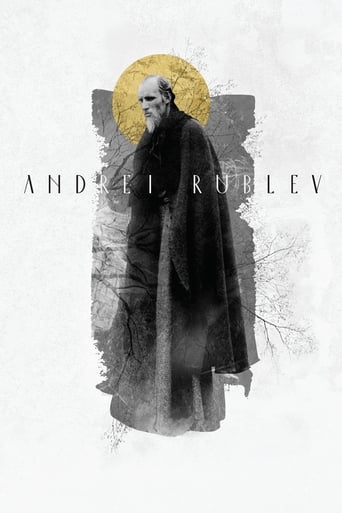15世纪初,鞑靼人的铁蹄践踏着大公割据的俄罗斯大地,黎民百姓在大公的暴政下水深火热,圣像画家安德烈·鲁勃廖夫就生活在这样的年代。在大公的邀请下,鲁勃廖夫前往莫斯科为教堂作画。但在创作的过程中,鲁勃廖夫却对圣像内容产生了巨大的质疑,这种矛盾的心态使他联想到现今俄罗斯民众经 受的磨难与自己为贵族服务的事实,最终,他毅然离开教堂回到了原先的修道院。 不久,鲁勃廖夫被迫再度回到莫斯科进行圣像创作,但这次他却亲临了所有俄罗斯人的苦难。大公的弟弟勾结鞑靼人篡位谋反,弗拉基米尔城的居民被无辜残杀,教堂在战火中摧毁,画家的眼中全是地狱的景象……鲁勃廖夫再次陷入艺术与现实反差的困境,他又回到安德洛尼科夫修道院,将自己完全封闭,拒绝继续作画。 经过多年的反抗征战,鞑靼人的军队终于被赶出俄罗斯的大地。1423年,大公第三次邀请鲁勃廖夫到莫斯科作画,在一个铸钟少年的感染下,鲁勃廖夫最终完成了《三位一体》的传世名作。
"Андрей Рублёв" (1966), a cinematic masterpiece directed by Andrei Tarkovsky and produced by Mosfilm and Tvorcheskoe Obedinienie Pisateley i Kinorabotnikov in the Soviet Union, is a profound exploration of the life and times of the iconic 15th-century Russian icon painter, Andrei Rublev. The film delves deep into the spiritual and existential struggles of its protagonist, set against the backdrop of medieval Russia's tumultuous socio-political landscape. Tarkovsky's visionary approach to storytelling, characterized by long, contemplative shots and a non-linear narrative, invites viewers to immerse themselves in the inner world of Rublev, as he grapples with the violence and chaos around him, ultimately finding solace and purpose in his art. The film's visual language is as striking as its thematic depth, with each frame meticulously crafted to evoke the essence of medieval Russia. From the stark, monochromatic scenes that dominate much of the film to the vibrant, almost otherworldly colors of Rublev's icons, Tarkovsky masterfully uses cinematography to mirror the protagonist's journey from despair to enlightenment. The film's pacing, often slow and deliberate, allows for a meditative experience that encourages viewers to reflect on the broader implications of Rublev's struggles, such as the role of art in times of crisis and the enduring quest for meaning amidst suffering. "Andrey Rublev" also stands out for its unflinching portrayal of the brutality and corruption that plagued medieval Russia, challenging the romanticized notions of the period often found in historical narratives. The film does not shy away from depicting the harsh realities faced by its characters, including scenes of violence and oppression that underscore the film's central themes of faith, redemption, and the human condition. Through these depictions, Tarkovsky invites a critical examination of the past, urging viewers to consider how history's lessons can inform our understanding of the present. Despite facing significant censorship and controversy upon its release, "Андрей Рублёв" has since been recognized as a landmark achievement in world cinema, celebrated for its artistic innovation and philosophical richness. The film's enduring legacy lies in its ability to transcend time and place, offering a timeless meditation on the power of creativity and the resilience of the human spirit. As such, "Андрей Рублёв" remains a testament to Tarkovsky's genius and a poignant reminder of the transformative potential of art.
年份1966
运行时间205 分
收入24173$
在线观看
类型剧情历史
制作国家Soviet Union

